Virtual reality is revolutionizing dance by breaking physical limitations for diverse abilities. You’ll find immersive environments where motion capture and AI provide real-time feedback tailored to your unique movements. VR dance therapy improves balance, coordination, and mental wellbeing while connecting you to a global community of dancers. With customizable avatars and adaptive interfaces, even slight movements can translate into full expressions. Discover how this $7.63 billion emerging market is transforming movement accessibility for everyone.
The Evolution of Adaptive Dance in Virtual Reality
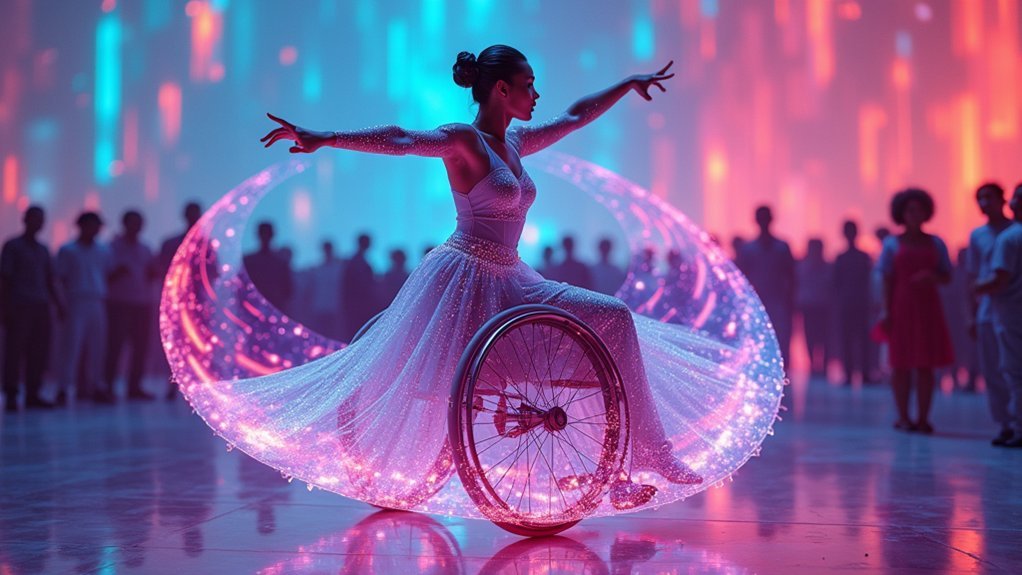
While traditional dance has always been confined to physical spaces, virtual reality has profoundly transformed how we experience, learn, and perform dance.
You’re now able to practice with digital instructors in immersive environments, receiving real-time feedback without physical limitations.
VR dance training systems leverage motion capture technology and wearable sensors to track your movements precisely. These systems offer 360-degree viewing experiences that make instructors appear as if they’re physically present with you.
Today’s VR dance systems precisely capture every move through advanced motion tracking and wearable sensor technology
Machine learning algorithms analyze your temporal data—joint positions and rotations—providing personalized feedback tailored to your skill level.
The integration of contrastive learning has greatly improved the accuracy of movement evaluation, making self-training more effective than ever.
You’ll find these systems break down complex choreography into specific instructional items, targeting areas where you need improvement.
This technological revolution isn’t just changing how you learn—it’s redefining what’s possible in dance itself.
How VR Technology Transforms Movement for Diverse Abilities
When considering how VR reshapes movement possibilities, the technology’s most revolutionary impact emerges in its ability to transcend physical limitations for people with diverse abilities.
You’ll find VR creates customized environments tailored specifically to your needs, allowing you to perform movements through natural interactions with virtual worlds. The immersive nature of these experiences stimulates neural pathways, potentially repairing damaged connections by simulating full motion despite physical restrictions.
This technology isn’t limited to physical rehabilitation—it extends to cognitive training, balance improvement, and pain management. Studies show VR rehabilitation leads to higher physical function compared to traditional methods, with one study demonstrating 96% improvement in the VR group versus 87% in control groups. As you engage with VR systems, you’ll experience adaptive environments that adjust to your performance level, maintaining an ideal challenge that promotes neuroplasticity.
With AI integration enhancing personalized feedback and the cost-effectiveness of virtual solutions, VR opens unprecedented possibilities for movement rehabilitation across diverse abilities.
Success Stories: Dancers Thriving in Virtual Environments
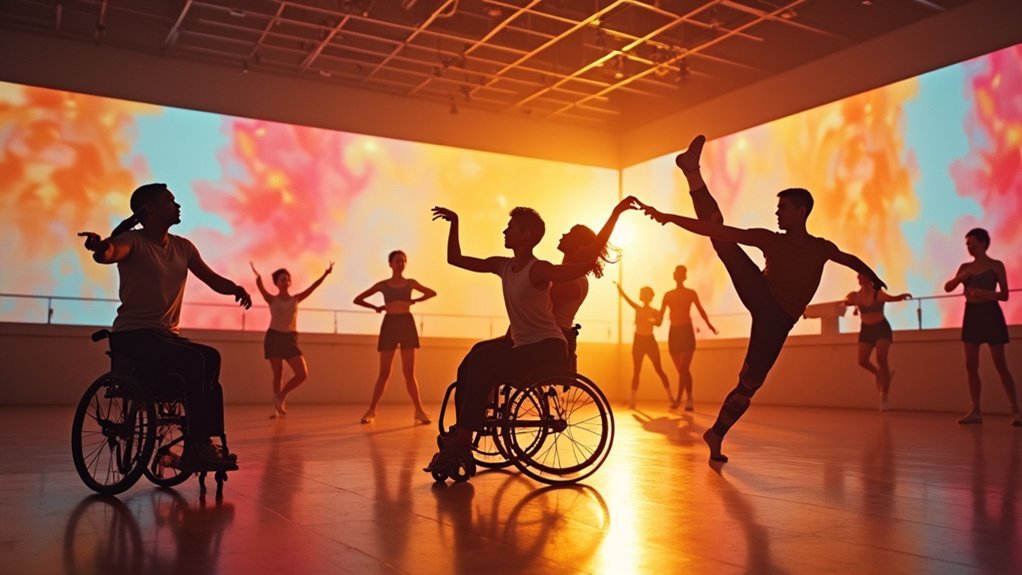
As technology bridges the gap between physical limitations and artistic expression, remarkable success stories have emerged from dancers embracing virtual environments.
You’ll find participants healing from trauma through movement in digital spaces that offer safety for emotional exploration without geographical constraints.
Virtual dance therapy has transformed couples’ relationships, improving communication through shared movement experiences.
Dancers with neurological conditions report significant improvements in balance and physical function while experiencing reduced depression symptoms.
What makes these success stories particularly powerful is their global reach—you’re connecting with diverse dancers across cultural boundaries while receiving personalized coaching adapted to your specific needs.
The virtual community provides essential support, creating lasting impacts that continue long after sessions end. Clients like Femke discovered it’s possible to express authentic power and establish healthy boundaries through somatic movement processes.
These environments don’t just accommodate limitations—they transcend them.
Essential VR Equipment for Adaptive Dance Programs
The transformative power of virtual reality in adaptive dance requires specific equipment tailored to dancers with diverse abilities. You’ll need VR headsets that create immersive environments where you can explore movement without physical constraints, alongside motion capture sensors that track your unique movements and provide personalized feedback. The Koros event showcases how VR technology enables audiences to experience dance in proximity to performers in ways not possible with traditional performances.
- Motion tracking wearables continuously monitor your technique, offering real-time corrections to enhance your form.
- Virtual platforms give you access to dance studios and classes from anywhere, eliminating geographical barriers.
- Interactive choreography tools enable you to create and simulate complex dance sequences that match your abilities.
These technologies work together to create accessible dance experiences while reducing costs associated with traditional dance education and physical infrastructure.
Creating Inclusive Virtual Dance Communities
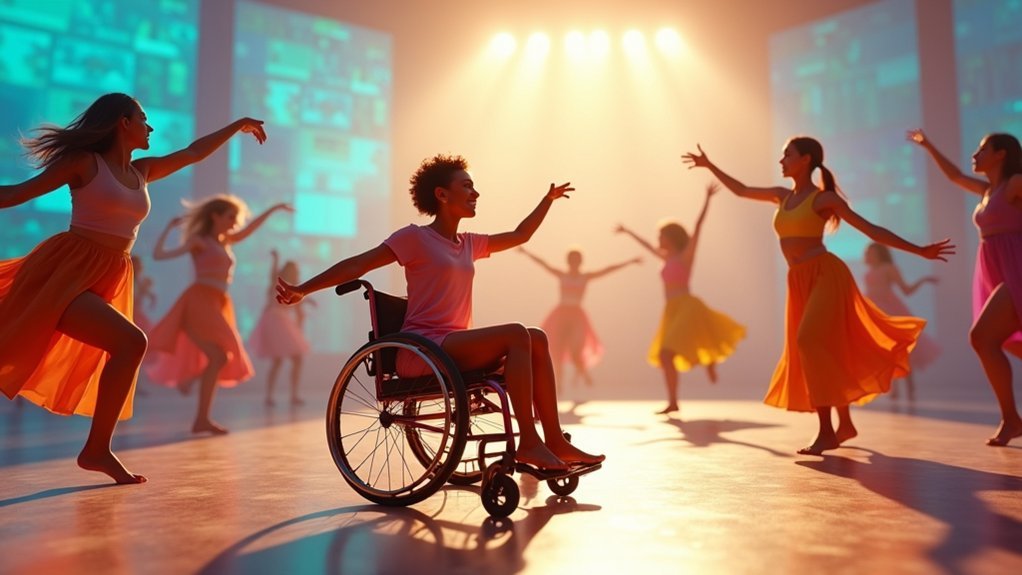
You’ll discover that inclusive virtual dance communities thrive on accessible digital platforms where everyone can participate regardless of physical limitations.
Through your screen, you’re able to connect with dancers worldwide who share your passion while controlling your level of visibility and interaction.
These digital spaces empower you to express yourself in a supportive environment where technology bridges gaps that physical spaces cannot. VR technologies create immersive experiences for independent learning with virtual teachers or avatars.
Connection Through Screens
How can dance transcend physical space and connect us across continents? Through your screen, you’re now part of a growing virtual dance community that breaks traditional barriers.
You’ll find these digital spaces aren’t just convenient alternatives—they’re powerful platforms for connection.
Virtual dance communities offer unique advantages:
- Cost-effective participation without travel expenses
- Access to diverse cultural styles and techniques from global instructors
- Inclusive environments welcoming those with physical limitations
As technology evolves, your virtual dance experience becomes increasingly immersive. The dance studio industry demonstrated remarkable resilience post-pandemic with students eager to engage both virtually and in-person.
VR and AR create environments where you can interact with dancers worldwide in real-time. These technological innovations don’t just replicate in-person experiences—they create entirely new possibilities for expression and connection, allowing you to engage with dance regardless of your location or physical circumstances.
Accessible Digital Platforms
Digital accessibility has revolutionized dance participation, creating spaces where physical limitations no longer define who can join the movement.
You’ll find tailored experiences accommodating diverse abilities, with adaptive movements and adjustable pacing that physical classes often can’t provide.
The statistics speak volumes—online platforms have attracted 74-83% of older adults for social interaction, while app-based and VR dance programs show growing interest (37-51%).
For individuals with Parkinson’s disease, these virtual environments offer safe, stigma-free alternatives with promising engagement rates.
Technical features like captioning and adaptable interfaces make participation possible for those with sensory or mobility impairments.
Research confirms that digital dance programs serve as a low-cost, accessible adjunct to standard clinical treatment for people with Parkinson’s disease.
With the online dance training market projected to reach $7.63 billion by 2032, you’re witnessing an inclusive revolution where everyone can experience the joy of dance.
Physical and Mental Health Benefits of VR Dance Therapy
While traditional dance therapy has long been recognized for its therapeutic value, virtual reality dance therapy now offers a revolutionary approach that amplifies these benefits for individuals with physical limitations.
You’ll experience improvements in both body and mind as you engage with immersive dance environments tailored to your abilities.
Research shows VR dance therapy delivers significant health benefits:
Virtual reality dance transforms therapy, delivering proven health benefits that traditional approaches cannot match.
- Improved physical function, including better balance and coordination for Parkinson’s patients and enhanced recovery for stroke survivors
- Reduced anxiety and depression, with studies showing better outcomes than traditional CBT for body image concerns
- Enhanced cardiac autonomic control, supporting heart health while providing adaptable movement options for various conditions
These evidence-based benefits make VR dance therapy a powerful option for those seeking inclusive movement experiences despite physical challenges. The integration of Dance Movement Therapy in Extended Reality environments creates immersive therapeutic experiences that can be customized to address specific mental health needs.
Future Innovations: Where Adaptive VR Dance Is Heading
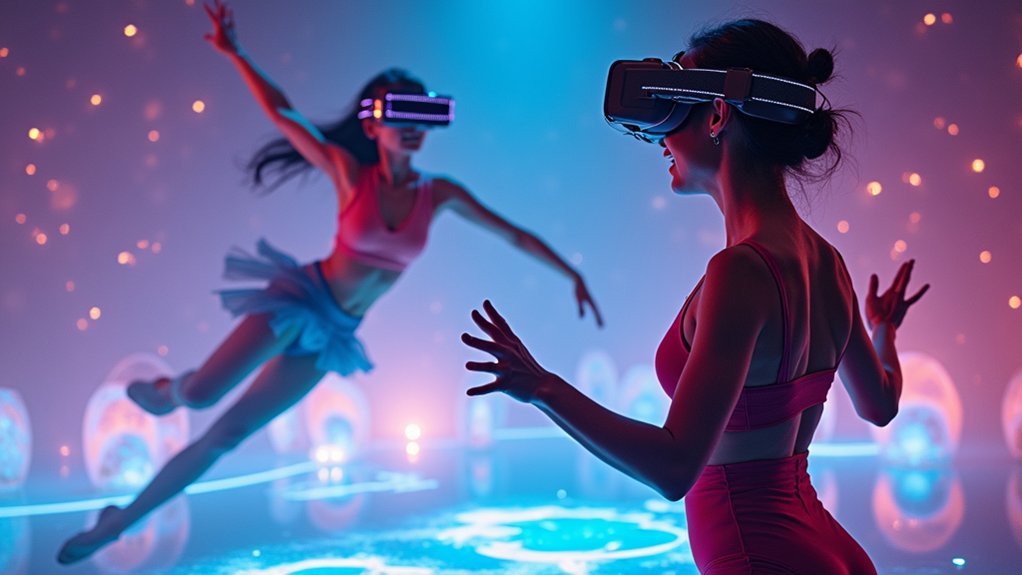
You’ll soon experience unprecedented freedom in VR dance as body-tracking technology evolves to interpret even subtle movements from users with limited mobility.
The digital domain will transform accessibility by eliminating physical barriers through customizable avatars and adaptive interfaces that respond to your unique capabilities. Hybrid dance styles will flourish in these virtual environments, allowing users to experiment with blending multiple genres regardless of physical ability.
These innovations will create inclusive virtual spaces where you can express yourself through movement regardless of physical limitations, connecting with dancers worldwide in shared immersive experiences.
VR’s Immersive Movement Potential
As adaptive VR dance technology leaps forward, we’re witnessing a revolutionary transformation in how movement can be experienced beyond physical limitations.
You’ll soon interact with AI dance partners that respond creatively to your movements, regardless of where you’re physically located. Research led by the German Research Center for Artificial Intelligence is pioneering these advances through collaborative efforts across Europe.
The immersive potential of VR dance environments extends far beyond traditional boundaries:
- Experience choreography from multiple perspectives—even from within a dancer’s viewpoint
- Train with personalized AI programs that adapt to your progress and physical capabilities
- Express yourself through dance even if mobility challenges previously limited your participation
These innovations democratize dance by removing geographic, physical, and financial barriers that once restricted participation, creating new pathways for artistic expression and movement therapy accessible to virtually everyone.
Accessibility Through Digital Worlds
The future of adaptive VR dance technology promises to dissolve barriers that have traditionally excluded many from dance participation.
You’ll soon experience machine learning systems that can interpret your slightest movements, translating them into full-body dance expressions regardless of your mobility range.
Emerging innovations include eye tracking and voice command controls that adapt to your unique abilities.
Dynamic interfaces will allow you to customize virtual dancers’ placement and scale to match your comfort level and reach capabilities.
What’s most exciting is how these technologies are reshaping choreography itself.
Mixed reality environments now enable real-time adjustments during creation, while personalized feedback systems guide you through movements at your own pace.
These developments aren’t just making dance more accessible—they’re reimagining what dance can be, with technology like AR ballet mentors providing instruction that can be accessed anywhere through smartphone applications.
Frequently Asked Questions
How Are VR Dance Programs Funded for Low-Income Participants?
You’ll find VR dance programs for low-income participants funded through government grants, non-profit foundations, arts-specific programs, community partnerships, and fundraising events. These sources often provide equipment, training, and subsidized participation fees.
Can Seniors With Limited Technology Experience Participate in VR Dance?
Yes, you can participate in VR dance despite limited tech experience. Many programs offer simplified interfaces, hands-on training, and supportive staff specifically designed to help seniors overcome technology barriers and enjoy the experience.
What Qualifications Should Adaptive VR Dance Instructors Have?
To teach adaptive VR dance, you’ll need dance experience, VR technology knowledge, adaptive teaching training, and certifications in first aid. You should also possess patience, creativity, and strong communication skills.
Are There Competitions Specifically for Adaptive VR Dancers?
Currently, you won’t find competitions exclusively for adaptive VR dancers, though VR dance events are becoming more accessible. As this technology grows, you’ll likely see more inclusive competitions developing specifically for adaptive participants.
How Do Dancers Overcome Motion Sickness in VR Environments?
You can overcome VR motion sickness by starting with short sessions, using teleportation instead of walking locomotion, ensuring high frame rates, taking frequent breaks, and gradually building your tolerance through regular practice.
In Summary
You’re witnessing a revolution in dance through VR technology. You’ll find that physical limitations no longer define your ability to express yourself through movement. As you’ve seen, these virtual spaces create opportunities for all bodies to dance, connect, and heal. Don’t hesitate to join this growing community—you’re part of dance’s exciting future where everyone belongs.

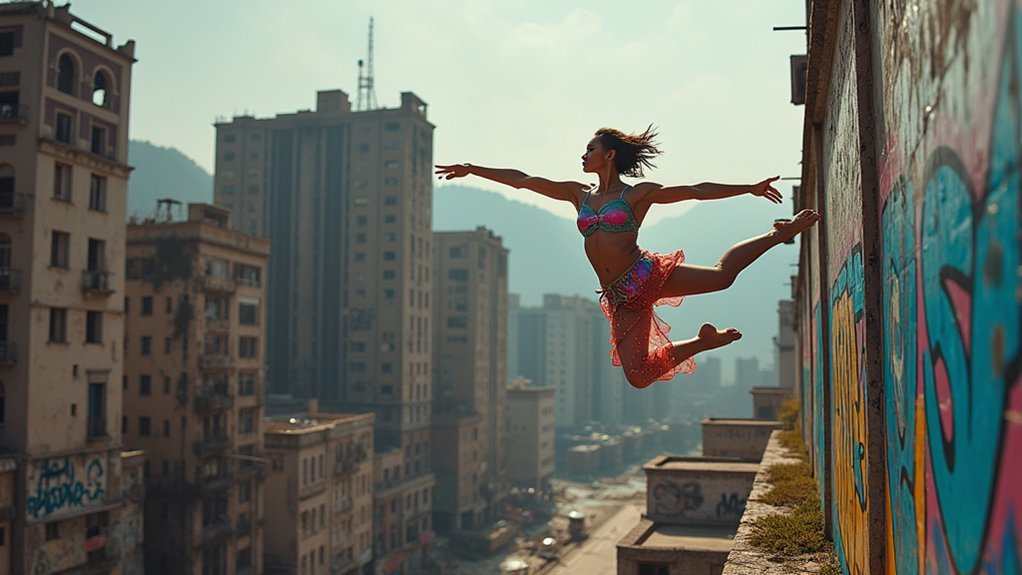



Leave a Reply